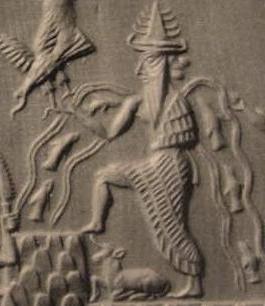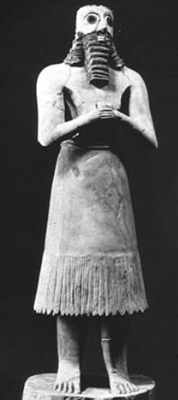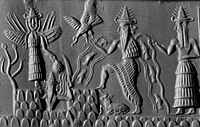
Enki is the Sumerian god of water, knowledge (gestú), crafts (gašam), and creation (nudimmud), and one of the Anunnaki. He was later known as Ea or Ae in Akkadian (Assyrian-Babylonian) religion, and is identified by some scholars with Ia in Canaanite religion. The name was rendered Aos in Greek sources.

Ninḫursaĝ, sometimes transcribed Ninursag, Ninḫarsag, or Ninḫursaĝa, also known as Damgalnuna or Ninmah, was the ancient Sumerian mother goddess of the mountains, and one of the seven great deities of Sumer. She is known earliest as a nurturing or fertility goddess. Temple hymn sources identify her as the "true and great lady of heaven" and kings of Lagash were "nourished by Ninhursag's milk". She is the tutelary deity to several Sumerian leaders.

Inanna is the ancient Mesopotamian goddess of love, war, and fertility. She is also associated with sensuality, procreation, divine law, and political power. Originally worshipped in Sumer, she was known by the Akkadian Empire, Babylonians, and Assyrians as Ishtar. Her primary title is "the Queen of Heaven".
Nammu was a Mesopotamian goddess regarded as a creator deity in the local theology of Eridu. It is assumed that she was associated with water. She is also well attested in connection with incantations and apotropaic magic. She was regarded as the mother of Enki, and in a single inscription she appears as the wife of Anu, but it is assumed that she usually was not believed to have a spouse. From the Old Babylonian period onwards, she was considered to be the mother of An (Heaven) and Ki (Earth), as well as a representation of the primeval sea/ocean, an association that may have come from influence from the goddess Tiamat.
Ninšar was a Mesopotamian goddess commonly associated with the preparation of meat. The reading of her name remains uncertain, and its possible etymology appears to be unrelated to her role in the Mesopotamian pantheon. She was chiefly worshiped in Nippur, though her original cult center was the settlement AB.NAGAR.
Ninkasi was the Mesopotamian goddess of beer and brewing. It is possible that in the first millennium BC she was known under the variant name Kurunnītu, derived from a term referring to a type of high quality beer. She was associated with both positive and negative consequences of the consumption of beer. In god lists, such as the An = Anum list and the Weidner god list, she usually appears among the courtiers of the god Enlil, alongside deities such as Ninimma and Ninmada. She could also be paired with Siraš, a goddess of similar character, who sometimes was regarded as her sister. A possible association between her and the underworld deities Nungal and Laṣ is also attested, possibly in reference to the possible negative effects of alcohol consumption.

Damgalnuna, also known as Damkina, was a Mesopotamian goddess regarded as the wife of the god Enki. Her character is poorly defined in known sources, though it is known that like her husband she was associated with ritual purification and that she was believed to intercede with him on behalf of supplicants. Among the deities regarded as their children were Nanshe and Asalluhi. While the myth Enki and Ninhursag treats her as interchangeable with the goddess mentioned in its title, they were usually separate from each other. The cities of Eridu and Malgium were regarded as Damgalnuna's cult centers. She was also worshiped in other settlements, such as Nippur, Sippar and Kalhu, and possibly as early as in the third millennium BCE was incorporated into the Hurrian pantheon. She appears in a number of myths, including the Enūma Eliš, though only a single composition, Damkina's Bond, is focused on her.

Nanshe was a Mesopotamian goddess in various contexts associated with the sea, marshlands, the animals inhabiting these biomes, namely bird and fish, as well as divination, dream interpretation, justice, social welfare, and certain administrative tasks. She was regarded as a daughter of Enki and sister of Ningirsu, while her husband was Nindara, who is otherwise little known. Other deities who belonged to her circle included her daughter Nin-MAR.KI, as well as Hendursaga, Dumuzi-abzu and Shul-utula. In Ur she was incorporated into the circle of Ningal, while in incantations she appears alongside Ningirima or Nammu.

Nisaba was the Mesopotamian goddess of writing and grain. She is one of the oldest Sumerian deities attested in writing, and remained prominent through many periods of Mesopotamian history. She was commonly worshiped by scribes, and numerous Sumerian texts end with the doxology "praise to Nisaba" as a result. She declined after the Old Babylonian period due to the rise of the new scribe god, Nabu, though she did not fully vanish from Mesopotamian religion and attestations from as late as the neo-Babylonian period are known.

Nanaya was a Mesopotamian goddess of love closely associated with Inanna.
Ninti was a Mesopotamian goddess worshiped in Lagash. She was regarded as the mother of Ninkasi. She also appears in the myth Enki and Ninhursag as one of the deities meant to soothe the eponymous god's pain. In this text, her name is reinterpreted first as "lady rib" and then as "lady of the month" through scribal word play.
Ninkurra or Ninkur was a name of multiple Mesopotamian deities, including a divine artisan, presumably a female sculptor. There is no agreement among researchers if this Ninkurra corresponds to the identically named goddess appearing in the myth Enki and Ninhursag. A different deity named Ninkur appears in enumerations of ancestors of Enlil in god lists. This theonym was also employed as a logogram to represent the name of a goddess worshipped in Mari and in Emar on the Euphrates, possibly to be identified as the wife of Dagan, Shalash.

Abu was a Mesopotamian god. His character is poorly understood, though it is assumed he might have been associated with vegetation and with snakes. He was often paired with the deity gu2-la2, initially regarded as distinct from Gula, but later conflated with her.
Ninimma was a Mesopotamian goddess best known as a courtier of Enlil. She is well attested as a deity associated with scribal arts, and is variously described as a divine scholar, scribe or librarian by modern Assyriologists. She could also serve as an assistant of the birth goddess Ninmah, and a hymn describes her partaking in cutting of umbilical cords and determination of fates. It has also been suggested that she was associated with vegetation. In the Middle Babylonian period she additionally came to be viewed as a healing deity.

The Barton Cylinder, also known as CBS 8383, is a Sumerian creation myth, written on a clay cylinder in the mid to late 3rd millennium BCE, which is now in the University of Pennsylvania Museum of Archaeology and Anthropology. Joan Goodnick Westenholz suggests it dates to around 2400 BC.
Bizilla was a Mesopotamian goddess closely associated with Nanaya and like her sometimes listed alongside courtiers of Inanna. However, she is also attested in connection with Ninlil, and it is assumed that she was viewed as the sukkal of this goddess in Ḫursaĝkalama near Kish.
Ninmug or Ninmuga was a Mesopotamian goddess. She was associated with artisanship, especially with metalworking, as evidenced by her epithet tibira kalamma, "metalworker of the land." She could also be regarded as a goddess of birth and assistant of Ninmah, most likely because the fashioning of statues of deities and the birth of children could be described with the same terms in Sumerian texts. Her main cult centers were Kisiga, whose location remains uncertain, and Adab.
Ninmada was a name applied to two separate Mesopotamian deities, a god and a goddess. The female Ninmada was a divine snake charmer, and in the myth Enki and Ninmah she appears as an assistant of the eponymous goddess. The male Ninmada was called the "worshiper of An" and was regarded as a brother of the snake god Ninazu. It is assumed that these deities could be partially conflated with each other or shared a similar origin, though proposals that there was only one Ninmada are also present in modern scholarship.
Meskilak or Mesikila was one of the two main deities worshiped in Dilmun. The other well attested member of the pantheon of this area was Inzak, commonly assumed to be her spouse. The origin of her name is a subject of scholarly dispute. She is also attested in texts from Mesopotamia, where her name was reinterpreted as Ninsikila. A different deity also named Ninsikila was the spouse of Lisin, and might have started to be viewed as a goddess rather than a god due to the similarity of the names. Under her Mesopotamian name Meskilak appears in the myths Enki and Ninhursag and Enki and the World Order, in which she is associated with Dilmun.
Aruru was a Mesopotamian goddess. The origin of her name is presently uncertain. While initially considered an independent deity associated with vegetation and portrayed in hymns as violent, she eventually came to be viewed as analogous Ninhursag. Her name could also function as an epithet of goddesses such as Nisaba and Ezina-Kusu. She was often called the older sister of Enlil. Her cult centers most likely were the cities of Kesh, Adab and Irisaĝrig. She appears in a number of literary texts, some of which preserve information about her original character. She is also present in the Epic of Gilgamesh, which portrays her as the creator of Enkidu.









